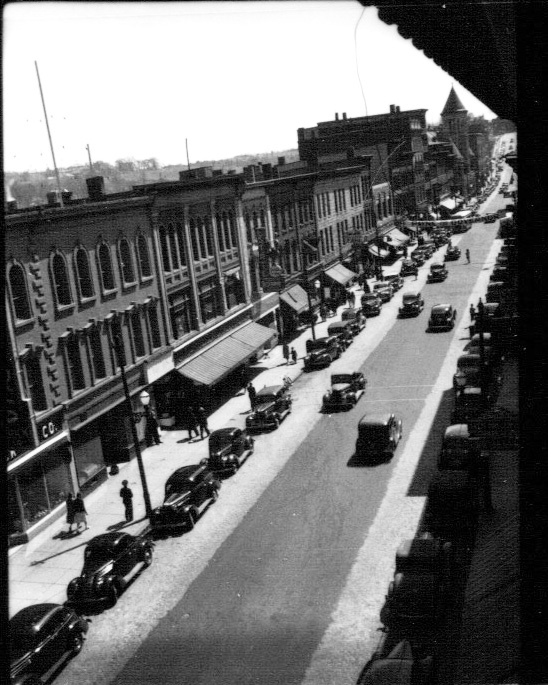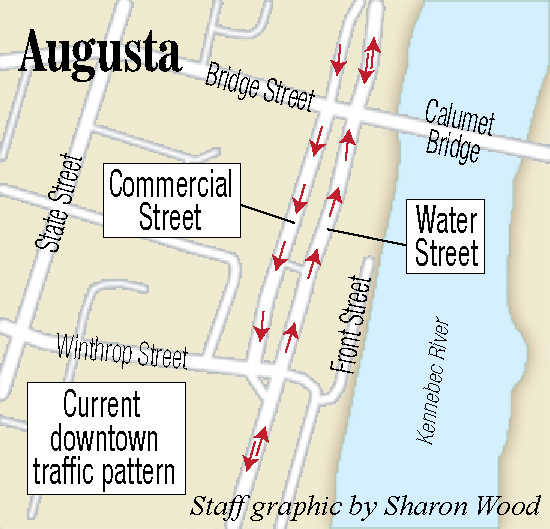AUGUSTA — A traffic expert said converting downtown Augusta from one-way to two-way traffic would help make downtown more of a place to go to, not just through.
The current design, Chester “Rick” Chellman told about 25 people, including many city officials, at a presentation Wednesday organized by the Augusta Downtown Alliance, follows design standards crafted in part to ensure people can drive out of downtown as quickly as possible.
“In my experience the (Maine Department of Transportation), I think they mandated this. I don’t think they care about it being a ‘to’ place; they want it to be a ‘through’ place,” Chellman said of traffic design standards.
Chellman, owner of New Hampshire-based TND Engineering, whom Michael Hall, executive director of Augusta Downtown Alliance, said is a renowned civil and traffic engineer known for his expertise in traffic patterns, said two-way traffic slows vehicles down, which not only makes pedestrians safer, it also makes them feel safer. And he said if a goal is to increase the number of pedestrians downtown, which would in turn increase the number of potential customers for downtown shops, you need to make sure pedestrians both are safe and feel safe.
He said in pedestrian-vehicle accidents, studies show when speeds are 20 mph or less, injuries are rare. But if speeds are above 38 mph, pedestrians usually are killed.
Mayor David Rollins said he’s heard from numerous residents who oppose changing the street to two-way traffic flow, and said they’re concerned it would slow them while driving. He said much of the community “is not a walking community.”
Chellman responded that the design criteria now in many states prioritizes vehicle travel. He said for urban streets in Maine, he wouldn’t recommend designing the street with pedestrians as the number one priority, either. He suggested designing with vehicles, pedestrians and bicyclists as equal, number one priorities.
The findings of a traffic study by a consultant hired by the city to look into the feasibility of changing to two-way traffic the one-way section downtown, between Bridge and Winthrop streets, determined it is possible to make the change, though doing so would cost about $100,000 and would eliminate 11 to 16 parking spaces.
Chellman, however, suggested two changes that could reduce that loss of parking spaces by six or seven spaces.
He disagreed with the traffic study’s finding that Water Street turning lanes would have to be lengthened on both sides of the street leading up to the Bridge Street intersection, to make more space for turning traffic to line up. He said the traffic design standards used to determine more turning lane space would be needed is based on a 95 percent standard, which he said means 95 percent of the time, there isn’t enough traffic to require the added space.
At-large Councilor Mark O’Brien said he feels downtown Augusta already is a “to place, not a through place.”
“If you go downtown, you’re not going that way to get anywhere else. I don’ t think there is a speed issue on Water Street,” he said. “I’m not a traffic engineer but am someone who has lived here 59 years. I don’t think that’s a reason we need to do it in Augusta.”
However downtown residents and merchants said vehicles going too fast in downtown Augusta are a problem. They included Hall, who said he was struck by a vehicle downtown.
Chellman said traffic pattern numbers indicate most vehicles coming onto the southern end of Water Street simply travel through and leave on the northern end, indicating most traffic is not stopping downtown.
Downtown advocates have said changing the one-way section of Water Street to two-way could help the ongoing revitalization of downtown, in part by increasing traffic and thus exposure for downtown businesses.
Opponents of changing to two-way traffic downtown have said the change wouldn’t be worth the loss of parking spaces it would require.
And city officials have expressed some concerns that firetrucks could have a hard time getting through two-way traffic on the street, and snow removal could be more challenging, if it is converted to two-way.
Changes to accommodate the change would include either eliminating or replacing a traffic island at the intersection of Water and Winthrop streets so trucks coming south could turn right off Water onto Winthrop. Crosswalks on Water Street would need to be upgraded to meet current American’s with Disabilities Act standards, an upgrade that eventually would be needed anyway. And traffic signals would have to be altered to reflect the new patterns.
Keith Edwards — 621-5647
Send questions/comments to the editors.





Success. Please wait for the page to reload. If the page does not reload within 5 seconds, please refresh the page.
Enter your email and password to access comments.
Hi, to comment on stories you must . This profile is in addition to your subscription and website login.
Already have a commenting profile? .
Invalid username/password.
Please check your email to confirm and complete your registration.
Only subscribers are eligible to post comments. Please subscribe or login first for digital access. Here’s why.
Use the form below to reset your password. When you've submitted your account email, we will send an email with a reset code.